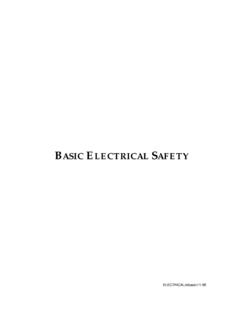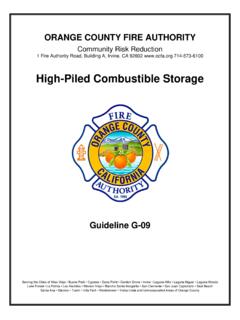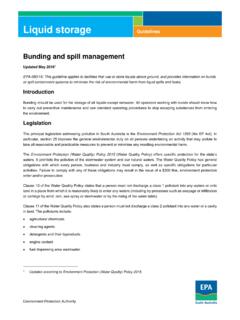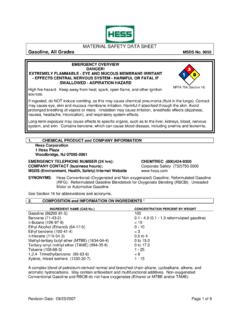Transcription of Flammable and Combustible Liquids - §1910.106(a)
1 HAZARDOUS MATERIALS/1910106a/1-95 Flammable and Combustible Liquids - (a)(18) Combustible liquid means any liquid having a flashpoint at or above 100F ( ).ooCombustible Liquids shall be divided into two classes as follows:(i) Class II Liquids shall include those with flashpoints at or above 100F ( ) and below 140 Fooo(60C), except any mixture having components with flashpoints of 200F ( ) or higher, theooovolume of which make up 99 percent or more of the total volume of the mixture. (ii) Class III Liquids shall include those with flashpoints at or above 140F (60C). Class III liquidsooare subdivided into two subclasses:(a) Class IIIA Liquids shall include those with flashpoints at or above 140F (60C) andoobelow 200F ( ), except any mixture having components with flashpoints of 200 Fooo( ), or higher, the total volume of which make up 99 percent or more of the totalovolume of the mixture.(b) Class IIIB Liquids shall include those with flashpoints at or above 200F ( ).
2 Thisoosection does not cover Class IIIB Liquids . Where the term "Class III Liquids " is used in thissection, it shall mean only Class IIIA Liquids .(iii) When a Combustible liquid is heated for use to within 300F ( ) of its flashpoint, it shalloobe handled in accordance with the requirements for the next lower class of Liquids .(19) Flammable liquid means any liquid having a flashpoint below 100F ( ), except anyoomixture having components with flashpoints of 100F ( ) or higher, the total of which makeooup 99 percent or more of the total volume of the mixture. Flammable Liquids shall be known asClass I Liquids . Class I Liquids are divided into three classes as follows:(i) Class IA shall include Liquids having flashpoints below 73F ( ) and having a boiling pointoobelow 100F ( ).oo(ii) Class IB shall include Liquids having flashpoints below 73F ( ) and having a boiling pointooat or above 100F ( ).oo(iii) Class IC shall include Liquids having flashpoints at or above 73F ( ) and below 100 Fooo( ).
3 OFLASH POINT -- the lowest temperature at which a Flammable liquid will give off enoughvapors to form an ignitable mixture with the air above the surface of the liquid or within Flammable LIMIT -- the percentage of vapor in the air above which a fire can'toccur because there isn't enough fuel: the mixture is said to be too Flammable LIMIT -- the percentage of vapor in the air above which there isn'tenough air for a fire: the mixture is said to be too DENSITY -- the weight of a Flammable vapor compared to air. (Air = 1). Vapors witha high density are more dangerous and require better ventilation because thay tend to flow alongthe floor and collect in low -- the Permissible Exposure Limit of the vapor according to OSHA standards, expressed inparts of vapor per million parts of contaminated air. The PEL is listed because many of thesesubstances present inhalation as well as fire of Some Flammable LiquidsClass IALiquidFlammableVaporPELF lashBoilingPointPoint(F)(F)ooLimitsDensi ty(ppm)Air = 1 Common NameOther NamesLELUEL1-1 DichloroethyleneVinylidene < < < IBLiquidFlammableVaporPELF lashBoilingPointPoint(F)(F)ooLimitsDensi ty(ppm)Air = 1 Common NameOther DisulfideCarbon ,2- DichloroethyleneAcetylene AlcoholEthanol, alcoholEthyl AlcoholWood alcohol, Ethyl KetoneMEK, Propyl Naphtha76 AlcoholIPA, ICLiquidFlammableVaporPELF lashBoilingPointPoint(F)(F)ooLimitsDensi ty(ppm)Air = 1 Common NameOther NamesLELUELI soamyl AcetateBanana IsobutylMIBK, (Petroleum)Mineral Spirits, EtherPropyl (Monomer)Vinyl IILiquidFlammableVaporPELF lashBoilingPointPoint(F)(F)ooLimitsDensi ty(ppm)
4 Air = 1 Common NameOther NamesLELUELI soamyl Oil #1 & #2100+-----Fuel Oil #4110+-----Fuel Oil #5130+ (coal tar) (High Flash)100 > Solvent,Stoddard SolventMethyl IIIL iquidFlammableVaporPELF lashBoilingPointPoint(F)(F)ooLimitsDensi ty(ppm)Air = 1 Common NameOther Liquids *LiquidBoiling Point (F)PEL (ppm)oCommon NameOther NamesCarbon Tetrachloride17110 ChloroformTrichloromethane14250 Ethylene Dibromide1,2-Dibromoethane27020 Methyl Chloroform1,1,1-Trichloroethane165350 Methylene ChlorideDichloromethane104500 PerchloroethyleneTetrachloroethylene2481 00 TrichloroethyleneTCE, Trichlor190100* Non- Flammable under normal conditions. Unstabilized trichloroethylene can decompose violently in presence of fine aluminum powder.








